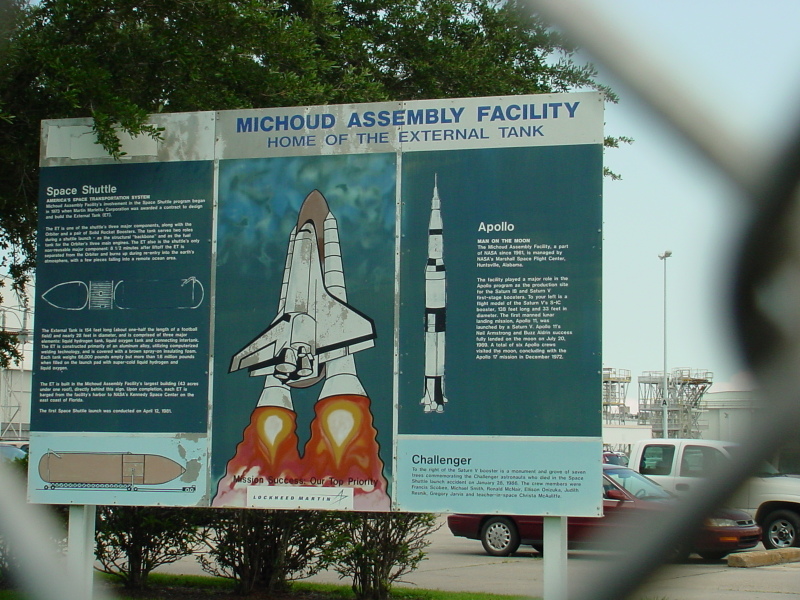| Prev |
heroicrelics.org Michoud Assembly Facility Site Index Michoud Assembly Facility Gallery |
Next |
dsc09615.jpg
The informational sign outside the facility.
It reads:
Michoud Assembly FacilityHome of the External Tank | |
Space ShuttleAmerica's Space Transportation SystemMichoud Assembly Facility's involvement in the Space Shuttle program began in 1973 when Martin Marietta Corporation was awarded the contract to design and build the External Tank (ET).The ET is one of the shuttle's three major components, along with the Orbiter and a pair of Solid Rocket Boosters. The tank serves two roles during a shuttle launch - as the structural "backbone" and as the fuel tank for the Orbiter's three main engines. The ET also is the shuttle's only non-reusable major equipment: 8 1/2 minutes after liftoff the ET is separated from the Orbiter and burns up during re-entry into the earth's atmosphere, with a few pieces falling into a remote ocean area. The External Tank is 154 feet long (about one-half the length of a football field) and nearly 28 feet in diameter, and is comprised of three major elements: liquid hydrogen tank, liquid oxygen tank, and connecting intertank. The ET is constructed primarily of an aluminum alloy, utilizing computerized welding technology, and is covered with a brown spray-on insulating foam. Each tank weighs 66,000 pounds empty but more than 1.6 million pounds when filled on the launch pad with super-cold liquid hydrogen and liquid oxygen. The ET is built in the Michoud Assembly Facility's largest building (43 acres under one roof), directly behind this sign. Upon completion, each ET is barged from the facility's harbor to NASA's Kennedy Space Center on the east coast of Florida. The first Space Shuttle launch was conducted on April 12, 1981. |
ApolloMan on the MoonThe Michoud Assembly Facility, a part of NASA since 1961, is managed by NASA's Marshall Space Flight Center, Huntsville, Alabama.The facility played a major role in the Apollo program as the production site for the Saturn IB and Saturn V first-stage boosters. To your left is a flight model of the Saturn V's S-IC booster, 138 feet long and 33 feet in diameter. The first manned lunar landing mission, Apollo 11, was launched by a Saturn V. Apollo 11's Neil Armstrong and Buzz Aldrin successfully landed on the moon on July 20, 1969. A total of six Apollo crews visited the moon, concluding with the Apollo 17 mission in December 1972. |
ChallengerTo the right of the Saturn V booster is a monument and grove of seven trees commemorating the Challenger Astronauts who died in the Space Shuttle launch accident on January 28, 1986. The crew members were Francis Scobee, Michael Smith, Ronald McNair, Ellison Onizuka, Judith Resnik, Gregory Jarvis, and teacher-in-space Christa McAuliffe. | |
The sign has apparently been moved, as it refers to the S-IC being to the sign's left, while in fact the booster is to the right of the sign.

| Time picture taken | Tue Jun 14 14:40:33 2005 |
| Location picture taken | Michoud Assembly Facility New Orleans, Louisiana |
| Prev | Michoud Assembly Facility Gallery | Next |